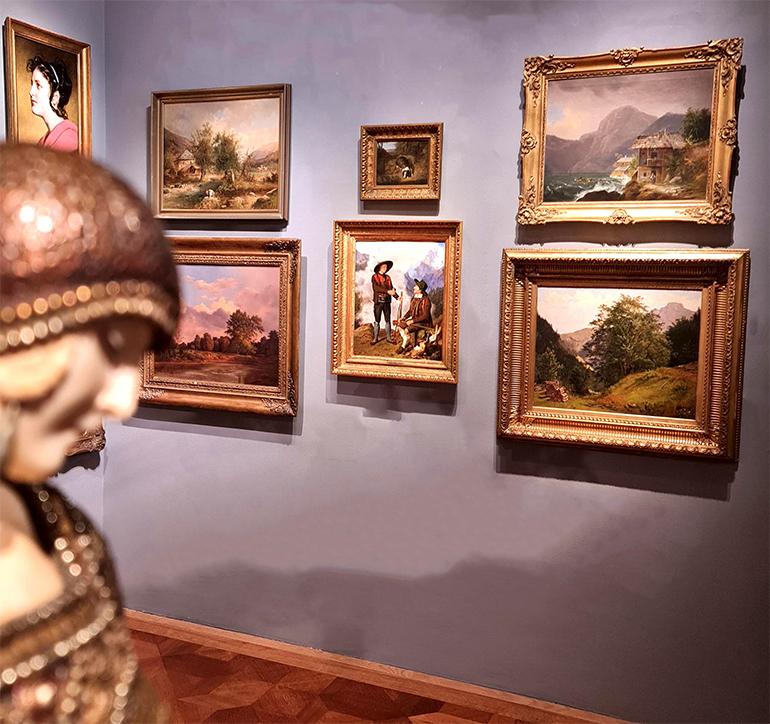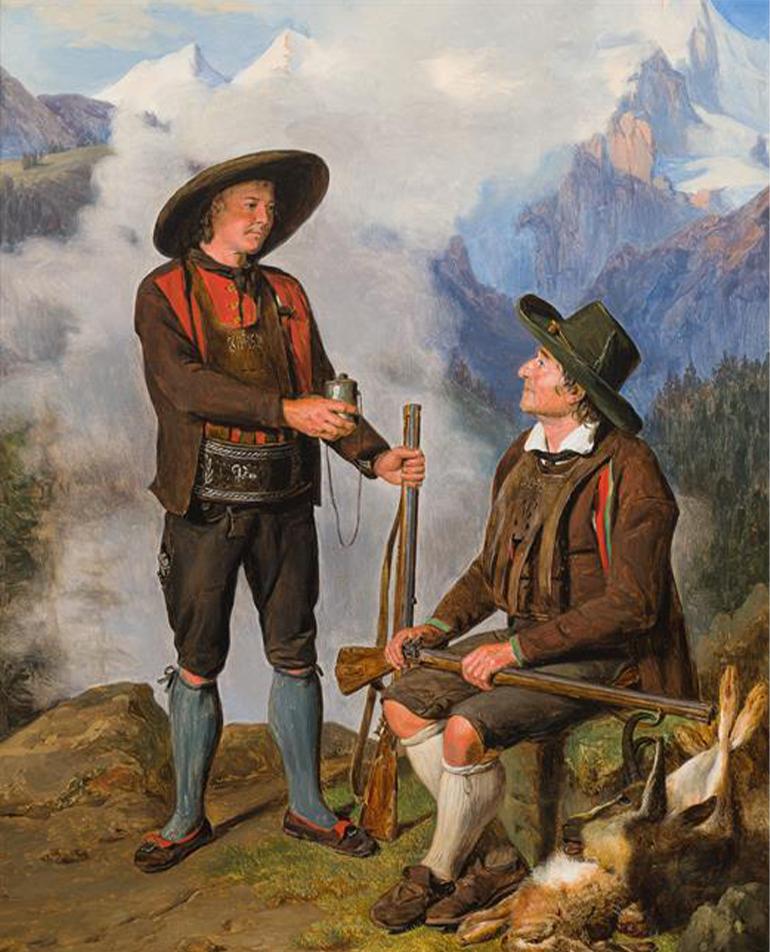"The high quality of the painting captivated me immediately. I was instantly fascinated by the fine brushstrokes and the reproduction of the different materials, which Waldmüller mastered so perfectly, as well as by the portraits of the faces, which are not 'types' but people of flesh and blood, which the artist knew how to create very individually.“
(Mag. Monika Schweighofer)

Tyrolean hunter in Waldmüller's work
He stands there like a hero, the hunter with the morning drink, wide-legged and proud. His gaze, however, is directed downwards and rests on the face of his companion. This weakens the impression of heroism and underlines the interaction between the two. The standing huntsman hands his companion, who has taken a seat on a rock, a metal vessel, probably filled with a high-proof drink.
In the lower right corner, at the feet of the sitting hunter, the hunted animals attract the attention of the observer. They are the prey of the present hunt, a hare and a chamois. Their fur is depicted so realistically that one would like to touch it. A reference to his high standards for himself and his study of nature, which became his greatest teacher.

How may one imagine this study of nature? How was it received?
Monika Schweighofer: He made pencil sketches in his drawing books. Small oil sketches on paper were also often made on site, these served as models for the paintings executed in his studio. Waldmüller travelled a lot, always in search of exciting motifs, he constantly made studies of nature and particularly tried to depict sunlight. This was extremely "revolutionary" and modern in his time. Not many of his artist colleagues were able to understand this.
Waldmüller also demanded that the students of the academy, whose professor he was appointed in the year our picture was created, should study before nature. Especially at the academy his ideas got him in trouble with other professors, as copying Old Master paintings and plaster models was common practice for students at that time.
Waldmüller's artistic genius
The scenery is backed up by fog rising from the valley. From its resting place, half hidden by the wafts of mist, one looks out over a wooded valley, behind which rugged, snow-covered peaks rise, taking up almost the entire background.
In his unique style, Waldmüller portrays two Tyroleans in the traditional costume of the marksmen. In literature they are also called "Passeier". The Val Passiria is in South Tyrol and was the home of the Tyrolean freedom fighter Andreas Hofer.
How can this motif be explained? Why Tyrol?
MS: Waldmüller travelled a lot, but it was not until 1830 that he came to Tyrol. On his travels he mainly sought picturesque landscapes. The life of the rural population also fascinated him. However, not many people are familiar with motifs from Tyrol and therefore our painting is something special in the oeuvre of the artist.
Freedom and independence are metaphors for both hunting and marksmen. A possible reference by Waldmüller to the Tyrolean fight for freedom in 1809 is only a supposition. However, the marksmen's loyalty and attachment to the House of Habsburg may have been one of the reasons for the purchase by the imperial family.
It is therefore not surprising that Ferdinand Georg Waldmüller took up a motif which leaves a number of possible interpretations open. After all, he was also known as an unconventional, quarrelsome character who always remained true to his principles and created masterpieces in a "modern" way, far ahead of his time, which have lost none of their fascination even in the present day.
So how is it that this work can now be presented to our customers? Is there a story behind it?
MS: The painting has had an eventful history. It was already in the possession of the imperial family in 1848. After the First World War it was taken over by the Österreichische Galerie and given in exchange in 1924. Through the art trade it became part of the collection of Dr. Ludwig Wodicka. During the National Socialist era he was persecuted because of his Jewish origins and his art collection was confiscated. This painting was intended for the Führer Museum in Linz. After the war it was restituted to Ludwig Wodicka and was sold to a prominent Austrian private collection, namely that of Dr. Karl Ruhmann. In the 1980s it was offered on the art market again and purchased by the penultimate owner in a Viennese gallery. The latter finally bequeathed the painting to the person who brought it in.
